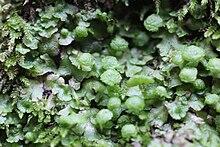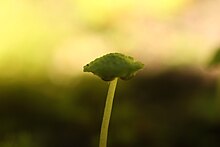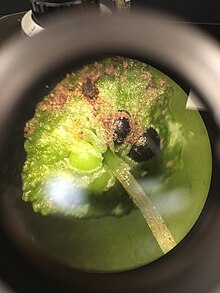178:, which in this species is pale green, flattened, dichotomously branched, thin, and somewhat shiny, measuring 0.6 to 1.5 cm long, less than 1 cm wide. The thallus margins are brownish purple in patches and somewhat undulate, curling upward when dry. The dorsal surface has a faint pattern of irregular polygons, and around inconspicuous pores to the air chambers below. The ventral surface is dark purple, shiny towards the margins, and green medially. The ventral scales are small, dark, and purple, poorly developed at maturity. The peculiar oil bodies found in so many liverworts are found scattered throughout the thallus, ventral scales, and sporogonial receptacle. Cryptomitrium does not reproduce asexually via
268:
190:
33:
46:
185:
It usually reaches its best development in
February or March, depending on the amount and distribution of the winter rainfall. During the long rainless season the plants dry up, the tips reviving and giving rise to new plants with the advent of the autumn rains.
312:
Wildfires are suspected to play a role in maintaining habitat. Capsules develop in late winter to early spring, depending on elevation. It is a poor competitor with vascular plants and populations tend to disappear as succession progresses.
281:
brown, nearly spherical, with very short seta, three to seven per receptacle, each opening by a lid; mauring in early spring. Spores brown, 35-450 um, more or less distinctly tetrahedral, irregularly
309:
occurs in
Mediterranean climates with cool wet winters and dry summers and forms small to locally extensive mats on bare and usually shaded humid soil on hillsides, rock outcrops, and streambanks.
264:
is easily recognized when mature, but earlier in its development may be more or less low-pyramidal; however, it is never lobed, and rather distinctive on this account.
256:
form a narrow, elongated, median, dorsal group lying immediately posterior to the female receptacle. The female receptacle is terminal. Its stalk has a single
260:
furrow. The disk is hemispherical when young but finally becomes circular and nearly flat. It is without lobes when mature. The distinctive discoid
622:
261:
661:
462:
402:
700:
228:, The genus name means “hidden turban” in reference to the inconspicuous sheath around the immature sporangium. The common name for
596:
635:
640:
764:
666:
759:
45:
562:
557:
705:
653:
627:
525:
287:
130:
679:
214:
by Austin before being revised into its current description by
Underwood in 1884. The genus
754:
583:
8:
692:
426:
Haupt, Arthur W. (1942). "Studies in
Californian Hepaticae. III. Cryptomitrium tenerum".
726:
505:
443:
356:
267:
189:
40:
162:
native to North
America. It is the only representative of its genus on the continent.
674:
570:
731:
500:
495:
435:
346:
575:
548:
77:
67:
687:
233:
179:
32:
748:
486:
Howe, Marshall Avery (1899). "The
Hepaticae and Anthocerotes of California".
216:
171:
107:
87:
718:
648:
609:
253:
221:
97:
509:
298:
are attenuate, 300-450 um contorted, often branched, and spiraled.
224:
with other liverworts with flat thalli and stalked receptacles, such as
601:
447:
360:
278:
245:
403:"An Assessment of the Rare Liverwort Cryptomitrium tenellum in Oregon"
614:
249:
225:
159:
519:
713:
542:
439:
351:
334:
291:
283:
257:
232:
is the flying saucer liverwort referring to the flat disc-shaped
175:
588:
295:
57:
379:
Field Guide to
Liverwort Genera of Pacific North America
335:"The Structure and Development of Cryptomitrium tenerum"
274:
sporangia taken through a dissecting microscope 25x
746:
400:
301:
31:
499:
376:
350:
248:. As in certain related species, such as
210:by Hooker, but later placed in the genus
460:
266:
188:
174:, it has a flat, dichotomously branched
463:"The Thallose Liverworts of California"
381:. San Francisco: Global Forest Society.
747:
401:Wagner, David; Emerson, Clint (2016).
332:
524:
523:
425:
488:Memoirs of the Torrey Botanical Club
485:
481:
479:
421:
419:
396:
394:
392:
390:
388:
372:
370:
328:
326:
197:spherical sporophytes visible below.
13:
14:
776:
476:
416:
385:
367:
323:
206:The species was originally named
44:
239:
454:
236:perched on a tall thin stalk.
165:
1:
316:
7:
201:
146:(Hook.) Austin ex Underwood
10:
781:
765:Bryophyta of North America
532:
470:Humboldt State University
136:
129:
41:Scientific classification
39:
30:
23:
377:Schofiled, W.B. (2002).
302:Distribution and habitat
501:2027/nyp.33433010770398
461:Whitmore, Alan (1982).
333:Abrams, Leroy (1899).
275:
198:
534:Cryptomitrium tenerum
307:Cryptomitrium tenerum
270:
230:Cryptomitrium tenerum
195:Cryptomitrium tenerum
192:
155:Cryptomitrium tenerum
140:Cryptomitrium tenerum
25:Cryptomitrium tenerum
272:Cryptmitrium tenerum
16:Species of liverwort
760:Flora of California
276:
208:Marchantia tenerum
199:
742:
741:
675:Open Tree of Life
526:Taxon identifiers
428:Botanical Gazette
410:US Forest Service
339:Botanical Gazette
220:is placed in the
151:
150:
772:
735:
734:
722:
721:
709:
708:
696:
695:
683:
682:
670:
669:
657:
656:
644:
643:
631:
630:
618:
617:
605:
604:
592:
591:
579:
578:
566:
565:
553:
552:
551:
521:
520:
514:
513:
503:
483:
474:
473:
467:
458:
452:
451:
423:
414:
413:
407:
398:
383:
382:
374:
365:
364:
354:
330:
170:Like most other
158:is a species of
142:
49:
48:
35:
21:
20:
780:
779:
775:
774:
773:
771:
770:
769:
745:
744:
743:
738:
730:
725:
717:
712:
704:
699:
691:
686:
678:
673:
665:
660:
652:
647:
639:
634:
626:
621:
613:
608:
600:
595:
587:
582:
574:
569:
561:
556:
547:
546:
541:
528:
518:
517:
484:
477:
465:
459:
455:
424:
417:
405:
399:
386:
375:
368:
331:
324:
319:
304:
244:The species is
242:
204:
168:
147:
144:
138:
125:
122:C. tenerum
78:Marchantiopsida
68:Marchantiophyta
43:
17:
12:
11:
5:
778:
768:
767:
762:
757:
740:
739:
737:
736:
732:wfo-0001196282
723:
710:
697:
684:
671:
658:
645:
632:
619:
606:
593:
580:
567:
554:
538:
536:
530:
529:
516:
515:
475:
453:
440:10.1086/335130
434:(2): 264–272.
415:
384:
366:
352:10.1086/327880
345:(2): 110–121.
321:
320:
318:
315:
303:
300:
241:
238:
234:sporangiophore
203:
200:
193:Receptacle of
167:
164:
149:
148:
145:
134:
133:
127:
126:
119:
117:
113:
112:
105:
101:
100:
95:
91:
90:
85:
81:
80:
75:
71:
70:
65:
61:
60:
55:
51:
50:
37:
36:
28:
27:
15:
9:
6:
4:
3:
2:
777:
766:
763:
761:
758:
756:
753:
752:
750:
733:
728:
724:
720:
715:
711:
707:
702:
698:
694:
689:
685:
681:
676:
672:
668:
663:
659:
655:
650:
646:
642:
637:
633:
629:
624:
620:
616:
611:
607:
603:
598:
594:
590:
585:
581:
577:
572:
568:
564:
559:
555:
550:
544:
540:
539:
537:
535:
531:
527:
522:
511:
507:
502:
497:
493:
489:
482:
480:
471:
464:
457:
449:
445:
441:
437:
433:
429:
422:
420:
411:
404:
397:
395:
393:
391:
389:
380:
373:
371:
362:
358:
353:
348:
344:
340:
336:
329:
327:
322:
314:
310:
308:
299:
297:
293:
289:
285:
280:
273:
269:
265:
263:
262:carpocephalum
259:
255:
251:
247:
237:
235:
231:
227:
223:
219:
218:
217:Cryptomitrium
213:
212:Cryptomitrium
209:
196:
191:
187:
183:
181:
177:
173:
172:Marchantiales
163:
161:
157:
156:
143:
141:
135:
132:
131:Binomial name
128:
124:
123:
118:
115:
114:
111:
110:
109:Cryptomitrium
106:
103:
102:
99:
96:
93:
92:
89:
88:Marchantiales
86:
83:
82:
79:
76:
73:
72:
69:
66:
63:
62:
59:
56:
53:
52:
47:
42:
38:
34:
29:
26:
22:
19:
693:tro-35185076
533:
491:
487:
469:
456:
431:
427:
409:
378:
342:
338:
311:
306:
305:
294:margin. The
277:
271:
243:
240:Reproduction
229:
215:
211:
207:
205:
194:
184:
169:
154:
153:
152:
139:
137:
121:
120:
108:
24:
18:
755:Aytoniaceae
649:NatureServe
610:iNaturalist
222:Aytoniaceae
166:Description
98:Aytoniaceae
749:Categories
688:Plant List
317:References
254:antheridia
246:monoecious
64:Division:
549:Q17295595
494:: 1–288.
290:, with a
288:lamellate
279:Sporangia
250:Asterella
226:Asterella
160:liverwort
116:Species:
54:Kingdom:
719:35185076
714:Tropicos
654:2.125623
628:10196445
543:Wikidata
510:43392211
472:: 90–91.
292:pellucid
284:areolate
202:Taxonomy
94:Family:
602:2688594
448:2472337
361:2465351
296:elaters
258:rhizoid
176:thallus
104:Genus:
84:Order:
74:Class:
58:Plantae
706:CRTE11
701:PLANTS
680:756397
667:122622
589:598395
563:418249
508:
446:
359:
252:, the
180:gemmae
641:15557
623:IRMNG
615:55256
506:JSTOR
466:(PDF)
444:JSTOR
406:(PDF)
357:JSTOR
662:NCBI
636:ITIS
597:GBIF
576:ZY6K
558:BOLD
727:WFO
584:EoL
571:CoL
496:hdl
436:doi
432:104
347:doi
751::
729::
716::
703::
690::
677::
664::
651::
638::
625::
612::
599::
586::
573::
560::
545::
504:.
490:.
478:^
468:.
442:.
430:.
418:^
408:.
387:^
369:^
355:.
343:28
341:.
337:.
325:^
182:.
512:.
498::
492:7
450:.
438::
412:.
363:.
349::
286:-
Text is available under the Creative Commons Attribution-ShareAlike License. Additional terms may apply.


